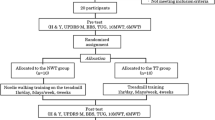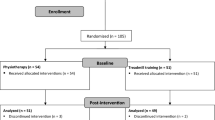Abstract
Introduction
Non-pharmacological interventions are increasingly being acknowledged as valuable options to overcome or reduce functional problems in patients with Parkinson’s disease. In the last decades, Nordic Walking was employed and investigated by rehabilitation specialists. Clinical trials on the effect of Nordic Walking on motor and non-motor Parkinson’s disease symptoms are few, small, and heterogeneous for inclusion criteria and intervention protocols. As a result, Nordic Walking training cannot be recommended as a standard rehabilitative tool in Parkinson’s disease patients.
Methods
This randomized controlled single-blind trial recruited Parkinson’s disease patients at a Hoehn and Yahr stage between 2 and 3 assigned to a Nordic Walking vs. Walking group. Subjects were extensively assessed for motor and non-motor symptoms at baseline and after 8 weeks of intervention period. To study the effects of intervention on the overall sample, paired-sample t test and Wilcoxon signed rank test were used, while differences between groups were estimated with general linear models repeated-measure and Mann–Whitney U test.
Results
Among 32 patients who ended the study period, improvements were observed in the following assessments: global motor outcome (p 0.001), dynamic and static balance ability (p 0.005; p 0.002), global non-motor symptoms outcome (p 0.003), fatigue (p 0.016), anxiety (p 0.043), and quality of life (p 0.003). The treatment group (Nordic Walking) failed to show any difference compared to the control group (Walking) in all considered outcomes.
Conclusion
Nordic Walking was not superior compared to Walking in the studied population. Moderate intensity outdoor group activities like Nordic Walking and Walking seem to improve motor and non-motor symptoms parameters in patients with Parkinson’s disease.

Similar content being viewed by others
References
Alves G et al (2008) Epidemiology of Parkinson’s disease. J Neurol 255:18–32
Pringsheim T et al (2014) The prevalence of Parkinson’s disease: a systematic review and meta-analysis. Mov Disord 29:1583–1590
Postuma RB et al (2015) MDS clinical diagnostic criteria for Parkinson’s disease. Mov Disord 30:1591–1601
Zesiewicz TA et al (2010) Practice parameter: treatment of nonmotor symptoms of Parkinson disease: report of the quality standards subcommittee of the American academy of neurology. Neurology 74:924–931
Montgomery EB Jr (2007) Practice Parameter: neuroprotective strategies and alternative therapies for Parkinson disease (an evidence-based review): report of the quality standards subcommittee of the American academy of neurology. Neurology 68:164 (author reply 164)
Abbruzzese G et al (2016) Rehabilitation for Parkinson’s disease: current outlook and future challenges. Parkinsonism Relat Disord 22:S60–S64
Dos Santos Delabary M et al (2018) Effects of dance practice on functional mobility, motor symptoms and quality of life in people with Parkinson’s disease: a systematic review with meta-analysis. Aging Clin Exp Res 30:727–735
Lotzke D, Ostermann T, Bussing A (2015) Argentine tango in Parkinson disease–a systematic review and meta-analysis. BMC Neurol 15:226
Schiffer T et al (2011) Mechanical and physiological effects of varying pole weights during Nordic walking compared to walking. Eur J Appl Physiol 111:1121–1126
Bang DH, Shin WS (2017) Effects of an intensive Nordic walking intervention on the balance function and walking ability of individuals with Parkinson’s disease: a randomized controlled pilot trial. Aging Clin Exp Res 29:993–999
Monteiro EP et al (2017) Effects of Nordic walking training on functional parameters in Parkinson’s disease: a randomized controlled clinical trial. Scand J Med Sci Sports 27:351–358
Ebersbach G et al (2010) Comparing exercise in Parkinson’s disease–the Berlin LSVT(R)BIG study. Mov Disord 25:1902–1908
Reuter I et al (2011) Effects of a flexibility and relaxation programme, walking, and nordic walking on Parkinson’s disease. J Aging Res 2011:232473
Cugusi L et al (2017) Nordic walking for the management of people with Parkinson disease: a systematic review. PM R 9:1157–1166
Bombieri F et al (2017) Walking on four limbs: a systematic review of Nordic walking in Parkinson disease. Parkinsonism Relat Disord 38:8–12
Fahn S et al (1987) Recent developments in Parkinson’s disease. Macmillan Health Care Inf 153–163:293–304
Bloem BR et al (2016) Measurement instruments to assess posture, gait, and balance in Parkinson’s disease: critique and recommendations. Mov Disord 31:1342–1355
Kegelmeyer DA et al (2007) Reliability and validity of the tinetti mobility test for individuals with Parkinson disease. Phys Ther 87:1369–1378
Kobayashi E, Himuro N, Takahashi M (2017) Clinical utility of the 6-min walk test for patients with moderate Parkinson’s disease. Int J Rehabil Res 40:66–70
Cugusi L et al (2015) Effects of a Nordic walking program on motor and non-motor symptoms, functional performance and body composition in patients with Parkinson’s disease. NeuroRehabilitation 37:245–254
Ebersbach G et al (2014) Impact of physical exercise on reaction time in patients with Parkinson’s disease-data from the Berlin BIG study. Arch Phys Med Rehabil 95:996–999
Thompson PD et al (2013) ACSM’s new preparticipation health screening recommendations from ACSM’s guidelines for exercise testing and prescription ninth edition. Curr Sports Med Rep 12:215–217
Acknowledgements
The authors would like to thank the physiotherapists of the physical and rehabilitation medicine ward in Villa Salus Hospital, as well as the ‘Kardines’ association and the Nordic Walking instructors for their participation and enthusiasm in this project.
Funding
This research did not receive any specific grant from funding agencies in the public, commercial, or non-for-profit sectors.
Author information
Authors and Affiliations
Contributions
SG: conception, organization, execution of research project; review and critique of statistical analysis; writing, review and critique of the first draft; AA: design and execution of statistical analysis; writing and review of the first draft; AL: execution of research project; review and critique of statistical analysis; writing and review of the first draft; DZ: execution of research project; AS: conception of the research project; review and critique of statistical analysis and of the first draft. All authors have approved the final version of the article.
Corresponding author
Ethics declarations
Conflict of interest
The authors declared that they have no conflict of interest.
Statement of human and animal rights
All procedures performed in studies involving human participants were in accordance with the ethical standards of the institutional and/or national research committee and with the 1964 Helsinki declaration and its later amendments or comparable ethical standards. This article does not contain any studies with animals performed by any of the authors.
Informed consent
All participants were fully informed about the nature, purpose, and procedures of the study and signed an informed consent form.
Additional information
Publisher's Note
Springer Nature remains neutral with regard to jurisdictional claims in published maps and institutional affiliations.
Rights and permissions
About this article
Cite this article
Granziera, S., Alessandri, A., Lazzaro, A. et al. Nordic Walking and Walking in Parkinson’s disease: a randomized single-blind controlled trial. Aging Clin Exp Res 33, 965–971 (2021). https://doi.org/10.1007/s40520-020-01617-w
Received:
Accepted:
Published:
Issue Date:
DOI: https://doi.org/10.1007/s40520-020-01617-w




